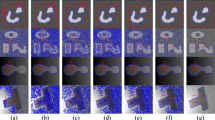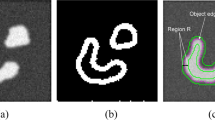Abstract
Employing prior information can greatly improve the segmentation result of many image segmentation problems. For example, a commonly used prior information is the shape of the object. In this paper, we introduce a different kind of prior information called the prior distribution. On the basis of non-parametric statistical active contour model, we add prior distribution energy to build a novel prior active contour model. During the convergence of contour curve, distribution difference between the inside and outside of the active contour is maximized while the distribution difference between the inside/outside of contour and the prior object/background is minimized. Furthermore, in order to improve the computation speed, a method to accelerate the computation speed is also proposed, which significantly relieves the burden of estimating probability density functions. As the experimental results suggest, satisfactory effects can be achieved in the segmentation of synthetic images and natural images via the our algorithm. Compared with the traditional non-parametric statistical active contour model without prior information, our method achieves a distinct improvement in both accuracy and computation efficiency.


















Similar content being viewed by others
References
Alpert S, Galun M, Brandt A, Basri R (2011) Image segmentation by probabilistic bottom-up aggregation and cue integration. IEEE Trans Pattern Anal Mach Intell 34(2):315–327
Bresson X, Vandergheynst P, Thiran J-P (2006) A variational model for object segmentation using boundary information and shape prior driven by the Mumford-Shah functional. Int J Comput Vis 68(2):145–162
Bresson X, Esedoḡlu S, Vandergheynst P, Thiran J-P, Osher S (2007) Fast global minimization of the active contour/snake model. J Math Imag Vis 28(2):151–167
Brown ES, Chan TF, Bresson X (2012) Completely convex formulation of the chan-vese image segmentation model. Int J Comput Vis 98(1):103–121
Caselles V, Kimmel R, Sapiro G (1997) Geodesic active contours. Int J Comput Vis 22(1):61–79
Chan T, Zhu W (2005) Level set based shape prior segmentation. In: Computer vision and pattern recognition, vol 2. IEEE, pp 1164–1170
Chan TF, Vese LA (2001) Active contours without edges. IEEE Trans Image Process 10(2):266–277
Chen Z, Fu Y, Xiang Y, Rong R (2017) A novel iterative shrinkage algorithm for CS-MRI via adaptive regularization. IEEE Signal Process Lett 24(10):1443–1447
Chen Z, Fu Y, Xiang Y, Rong R (2018) A novel low-rank model for MRI using the redundant wavelet tight frame. Neurocomputing 289:180–187
Cheng Z, Shen J, Miao H (2016) The effects of multiple query evidences on social image retrieval. Multimed Syst 22(4):509–523
Cohen LD (1991) On active contour models and balloons. CVGIP: Image Underst 53(2):211–218
Cremers D, Kohlberger T, Schnörr C (2003) Shape statistics in kernel space for variational image segmentation. Pattern Recogn 36(9):1929–1943
Foulonneau A, Charbonnier P, Heitz F (2006) Affine-invariant geometric shape priors for region-based active contours. IEEE Trans Pattern Anal Mach Intell 28 (8):1352–1357
Gong M, Li H, Zhang X, Zhao Qn, Wang B (2016) Nonparametric statistical active contour based on inclusion degree of fuzzy sets. IEEE Trans Fuzzy Syst 24(5):1176–1192
Hsieh C-W, Chen C-Y (2018) An adaptive level set method for improving image segmentation. Multimed Tools Appl 77(15):20087–20102
Kass M, Witkin A, Terzopoulos D (1988) Snakes: active contour models. Int J Comput Vis 1(4):321–331
Kim J, Fisher JW, Yezzi A, Çetin M, Willsky AS (2005) A nonparametric statistical method for image segmentation using information theory and curve evolution. IEEE Trans Image Process 14(10):1486–1502
Lankton S, Tannenbaum A (2008) Localizing region-based active contours. IEEE Trans Image Process 17(11):2029–2039
Leventon ME, Faugeras O, Grimson ELW, Wells WM (2000) Level set based segmentation with intensity and curvature priors. In: Mathematical methods in biomedical image analysis. IEEE, pp 4–11
Leventon ME, Grimson ELW, Faugeras O (2000) Statistical shape influence in geodesic active contours. In: Computer vision and pattern recognition, vol 1. IEEE, pp 316–323
Li B, Acton ST (2007) Active contour external force using vector field convolution for image segmentation. IEEE Trans Image Process 16(8):2096–2106
Li C, Xu C, Gui C, Fox MD (2005) Level set evolution without re-initialization: a new variational formulation. In: Computer vision and pattern recognition, vol 1. IEEE, pp 430–436
Li C, Kao C-Y, Gore JC, Ding Z (2007) Implicit active contours driven by local binary fitting energy. In: Computer vision and pattern recognition. IEEE, pp 1–7
Michailovich O, Rathi Y, Tannenbaum A (2007) Image segmentation using active contours driven by the Bhattacharyya gradient flow. IEEE Trans Image Process 16(11):2787–2801
Mitiche A, Ayed IB (2010) Variational and level set methods in image segmentation, vol 5. Springer Science & Business Media
Osher S, Sethian JA (1988) Fronts propagating with curvature-dependent speed: algorithms based on Hamilton-Jacobi formulations. J Comput Phys 79(1):12–49
Paragios N, Deriche R (2002) Geodesic active regions: a new framework to deal with frame partition problems in computer vision. J Vis Commun Image Represent 13 (1–2):249–268
Peng Y, Lu B-L (2017) Discriminative extreme learning machine with supervised sparsity preserving for image classification. Neurocomputing 261:242–252
Ronfard R (1994) Region-based strategies for active contour models. Int J Comput Vis 13(2):229–251
Schoenemann T, Kahl F, Masnou S, Cremers D (2012) A linear framework for region-based image segmentation and inpainting involving curvature penalization. Int J Comput Vis 99(1):53–68
Shao D, Zhang Y, Wei W (2009) An aircraft recognition method based on principal component analysis and image model matching. Chinese J Stereol Image Anal 3:7
Unal G, Yezzi A, Krim H (2005) Information-theoretic active polygons for unsupervised texture segmentation. Int J Comput Vis 62(3):199–220
Vese LA, Chan TF (2002) A multiphase level set framework for image segmentation using the mumford and shah model. Int J Comput Vis 50(3):271–293
Wu H, Appia V, Yezzi A (2013) Numerical conditioning problems and solutions for nonparametric iid statistical active contours. IEEE Trans Pattern Anal Mach Intell 35(6):1298–1311
Xu C, Prince JL (1998) Snakes, shapes, and gradient vector flow. IEEE Trans Image Process 7(3):359–369
Yu H, He F, Pan Y (2019) A novel segmentation model for medical images with intensity inhomogeneity based on adaptive perturbation. Multimed Tools Appl 78 (9):11779–11798
Zhu SC, Yuille A (1996) Region competition: unifying snakes, region growing, and Bayes/MDL for multiband image segmentation. IEEE Trans Pattern Anal Mach Intell 18(9):884–900
Zhuo T, Cheng Z, Zhang P, Wong Y, Kankanhalli M (2018) Unsupervised online video object segmentation with motion property understanding. arXiv:1810.03783
Acknowledgments
The work is supported by National Key R&D Program of China (2018YFC0309400), National Natural Science Foundation of China (61871188), Guangzhou city science and technology research projects(201902020008).
Author information
Authors and Affiliations
Corresponding author
Additional information
Publisher’s note
Springer Nature remains neutral with regard to jurisdictional claims in published maps and institutional affiliations.
Appendix: Derivation of the gradient flow formula
Appendix: Derivation of the gradient flow formula
In this section, we accomplished the derivation of gradient flow of the prior distribution-based statistical active contour model energy function. The proposed energy function in (23) shown as
To minimize the energy function, it is required to calculate the first derivative with respect to ϕ(x), i.e.,
It can be proved that [24],
where |R−|and |R+| respectively represent the area of the inside and outside regions that can be determined according to \({\int \limits }_{\varOmega } H(-\phi (x))\mathrm {d}x\) and \({\int \limits }_{\varOmega } H(\phi (x))\mathrm {d}x\).
Based on the equations above, the following equation is given:
where
Finally, the time parameter t is brought into the level set function in order to obtain the gradient vector flow of the minimum level set function:
Rights and permissions
About this article
Cite this article
Zhou, Z., Dai, M., Wang, T. et al. Prior distribution-based statistical active contour model. Multimed Tools Appl 78, 35813–35833 (2019). https://doi.org/10.1007/s11042-019-08101-2
Received:
Revised:
Accepted:
Published:
Issue Date:
DOI: https://doi.org/10.1007/s11042-019-08101-2




